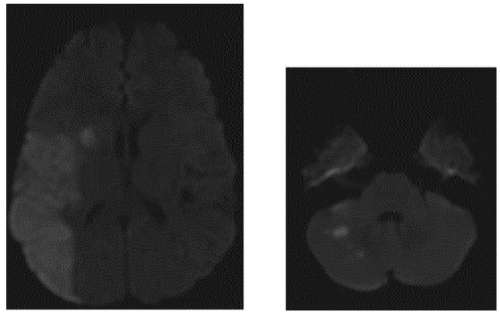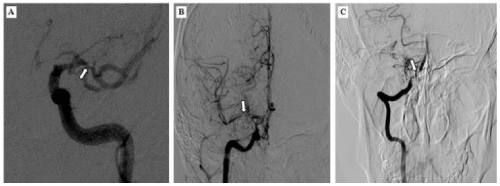Case Report Open Access
Stroke in a Young Patient: A Sentinel Presentation of Neurosyphilis and Human Immunodeficiency Virus (HIV)
| Shawna Cutting* and Elizabeth Flaherty | |
| Department of Neurology, Rush University Medical Center, Chicago, Illinois, USA | |
| *Corresponding Author : | Shawna Cutting Department of Neurology Rush University Medical Center 1725 West Harrison St, Chicago, Illinois, USA Tel: 3129424500 E-mail: Shawna_cutting@rush.edu |
| Received November 09, 2015; Accepted January 04, 2016; Published January 11, 2016 | |
| Citation: Cutting S, Flaherty E (2016) Stroke in a Young Patient: a Sentinel Presentation of Neurosyphilis and Human Immunodeficiency Virus (HIV). J Neuroinfect Dis 7:197.doi:10.4172/2314-7326.1000197 | |
| Copyright: © 2016 Cutting S, et al. This is an open-access article distributed under the terms of the Creative Commons Attribution License, which permits unrestricted use, distribution, and reproduction in any medium, provided the original author and source are credited. | |
Visit for more related articles at Journal of Neuroinfectious Diseases
Abstract
Objective: To describe a case of ischemic stroke in a young patient leading to diagnosis of concomitant neurosyphilis and HIV infections. Background: Meningovascular syphilis is an early manifestation of neurosyphilis which can lead to an infectious endarteritis (Heubner’s arteritis) and subsequent ischemic stroke. In the present era, early neurosyphilis is most frequently seen in patients with concomitant HIV infection and previous series have demonstrated that neurosyphilis a common sentinel presentation of HIV. However, clinicians may fail to inquire about at-risk behaviors and test for these infections in young stroke patients. Methods: Case report of a young patient with multifocal ischemic stroke admitted to our institution. Results: A 19 year-old male with a history of migraine headaches, worsened over several months, presented to a community hospital after awakening with left sided hemiplegia, numbness, and slurred speech. MRI brain revealed multifocal ischemic stroke in the middle cerebral artery territory and right cerebellum. After an unrevealing initial workup, he was transferred to our academic facility for further investigation. Cerebral angiogram revealed focal areas of high-grade stenosis affecting multiple vessels, and delayed filling of the intracranial circulation suggestive of vasculitis. Serum RPR was reactive, and the cerebrospinal fluid (CSF) profile showed a neutrophilic pleocytosis, with reactive CSF VDRL. HIV testing sent on admission was positive. The patient disclosed a history of unprotected sexual relationships with multiple male partners. He did not have a personal history of sexually transmitted infections, nor was he aware of previous infected partners. Conclusions: Neurosyphilis should be a diagnostic consideration in young patients with ischemic stroke. Clinicians should also be aware of the high incidence of concomitant syphilis and HIV in at-risk populations. Effort should be made to inquire about high-risk behaviors and initiate testing for these infections early in the diagnostic workup to avoid missing these crucial diagnoses.
| Introduction |
| There is increasing incidence of stroke over time in patients under 55 years of age [1]. Traditional risk factors are common and should be considered when determining stroke etiology in young patients [2]. Stroke due to an undiagnosed infectious etiology in a well-appearing patient is rare. We describe such a case. |
| Case Report |
| A 19 year old male with a history of migraine headaches, worsened over several months, presented to a community hospital after awakening with left sided hemiplegia, numbness, and slurred speech. Initial MRI brain revealed DWI positive lesions in the right MCA territory and right cerebellum, consistent with acute ischemic stroke (Figure 1). MR angiogram of the brain revealed a right M1 occlusion. Drug screen was positive only for marijuana. Further workup at the community hospital did not elucidate a clear etiology for his stroke and he was transferred to our academic facility for further investigation. |
| Examination on arrival revealed blunted affect, right gaze preference, left homonymous hemianopia, left hemiplegia, and extinction to left-sided stimulation, consistent with a right MCA syndrome. Cerebral angiogram revealed focal areas of high grade stenosis affecting multiple vessels (bilateral internal carotid, middle cerebral, and vertebral arteries), as well as delayed filling of the intracranial circulation suggestive of a vasculitis or moyamoya like pattern (Figure 2). Based on the appearance of this angiogram, a serum RPR was obtained and was reactive with a titer of >1:256. His cerebrospinal fluid (CSF) profile was also consistent with an infectious process (WBC 423/UL with 74% neutrophils, 19% lymphocytes, and 8% large monocytes, RBC 30/UL, glu-cose 20 mg/dL, protein 166 mg/dL), and demonstrated a reactive CSF VDRL. Treatment for meningovascular syphilis with a 14 day course of high dose intravenous penicillin G (4 million units IV q4hour) was initiated. |
| HIV testing was sent on admission and returned positive. Upon further questioning, the patient disclosed a history of sexual relationships with multiple male partners and intermittent condom use. He did not have a known personal history of sexually transmitted infections, nor was he aware of any previous infected partners. He was discharged to an acute rehabilitation program with plans to follow up with Infectious Diseases for outpatient treatment of HIV. |
| Discussion |
| Meningovascular syphilis is an early manifestation of neurosyphilis due to infection of the CSF, meninges, and CNS vasculature by Treponema pallidum. It can lead to an infectious endarteritis (Heubner’s arteritis) that generally affects large and medium sized vessels in the subarachnoid space, most commonly the MCA and its branches. This form of neurosyphilis may present as ischemic stroke in a young person. Personality changes and prodromal headache are often present [3]. In the present era, early neurosyphilis is most frequently seen in patients with concomitant HIV infection [4]. Concurrent HIV and syphilis infections are present among the same high risk groups, principally men who have sex with men and IV drug abusers. Syphilis and HIV infections likely enhance the transmission and acquisition of one another [5]. Our case demonstrates that, despite these observations, clinicians may yet fail to inquire about at-risk behaviors and test for these infections in young stroke patients. Neurosyphilis should be a diagnostic consideration in any young patient with ischemic stroke, and clinicians should initiate testing for syphilis early in the diagnostic workup to avoid missing this crucial diagnosis. |
References
- KisselaBM, Khoury JC, Alwell K, Moomaw CJ, Woo D, et al. (2012) Age at stroke: temporal trends in stroke incidence in a large, biracial population. Neurology 79: 1781-1787.
- Ji R, Schwamm LH, Pervez MA, Singhal AB (2013) Ischemic stroke and transient ischemic attack in young adults: risk factors, diagnostic yield, neuroimaging, and thrombolysis. 70: 51-57.
- Holmes MD, Brant-Zawadzki MM, Simon RP (1984) Clinical features of meningovascular syphilis. Neurology34:553-556.
- Chahine LM, Khoriaty RN, Tomford WJ, Hussain MS (2011) The changing face of neurosyphilis. Int J Stroke6:136-143.
- John DR, Tierney M, Felsenstein D (1987) Alteration in the natural history of neurosyphilis by concurrent infection with the human immunodeficiency virus. N Engl J Med 316:1569-1672.
Figures at a glance
 |
 |
| Figure 1 | Figure 2 |
Relevant Topics
- Bacteria Induced Neuropathies
- Blood-brain barrier
- Brain Infection
- Cerebral Spinal Fluid
- Encephalitis
- Fungal Infection
- Infectious Disease in Children
- Neuro-HIV and Bacterial Infection
- Neuro-Infections Induced Autoimmune Disorders
- Neurocystercercosis
- Neurocysticercosis
- Neuroepidemiology
- Neuroinfectious Agents
- Neuroinflammation
- Neurosyphilis
- Neurotropic viruses
- Neurovirology
- Rare Infectious Disease
- Toxoplasmosis
- Viral Infection
Recommended Journals
Article Tools
Article Usage
- Total views: 10486
- [From(publication date):
March-2016 - Apr 04, 2025] - Breakdown by view type
- HTML page views : 9487
- PDF downloads : 999
